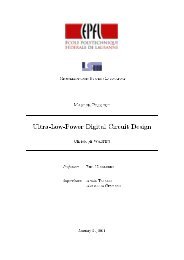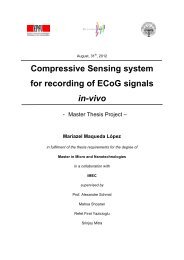"Linear Equation Solver using CMOS Technology" - Microelectronic ...
"Linear Equation Solver using CMOS Technology" - Microelectronic ...
"Linear Equation Solver using CMOS Technology" - Microelectronic ...
Create successful ePaper yourself
Turn your PDF publications into a flip-book with our unique Google optimized e-Paper software.
4.1.2. Revised DesignAll possible inputs that lead to a unique solution are generated in MATLAB (see Appendix 3.1). Inorder to verify the correct functionality of the solver design, the inputs are first simulated inMODELSIM. The circuit has only 138 assertion misses out of 27008 (1688 A matrices and 16 bmatrices for each) applied inputs (Figure 16). Despite such a high coverage ratio, the circuit fails forsome of the inputs. It is important to note that clock periods of 6 ns, 10 ns, 14 ns, 18 ns with eachhaving half of their period pulse widths are applied in the test bench (Appendix A1.7.2). Actually, theonly requirement regarding the clocks for the correct operation of the circuit is not to choose clockperiods which are the same (obvious), and integer multiples of each others, such as 2 ns, 4 ns, 6 ns, 8ns, or similarly. The simulation results are provided in Figure 15.Next, the transistor level simulations are performed for a detailed analysis. The simulation setup forthe revised solver design is provided in Appendix A1.7.2 . A binary2decimal converter is added forfacilitating the analysis of the outputs. 20 (out of 138) different problematic inputs observed in logicsimulations are simulated with a transient simulation time of 10 us for each.The simulation results are shown in Figure 17, 18 and 19. Unlike the MODELSIM simulations, justfor some input cases, the circuit fails and the numerical oscillations are observed. The differenceoriginates from the fact that the simulation methods are different for the logic and transistor levelsimulations. However, the latter provides more precise and accurate results. Therefore, eachsuccessfully solvable input in MODELSIM simulations is also expected to be solved in transistor levelsimulations, but the opposite is not correct as observed in the simulations.28















